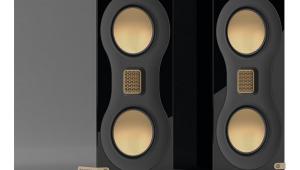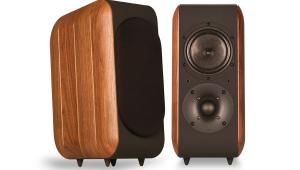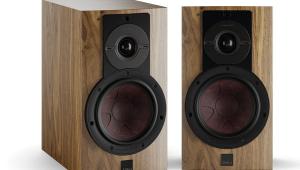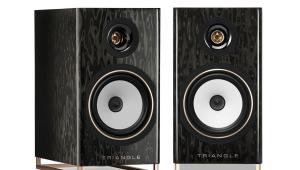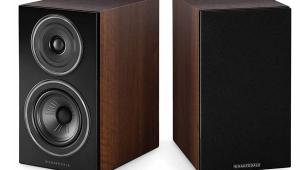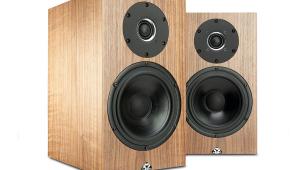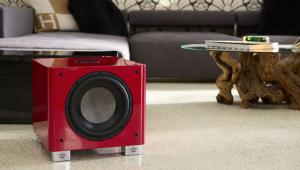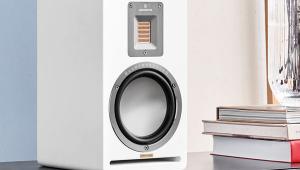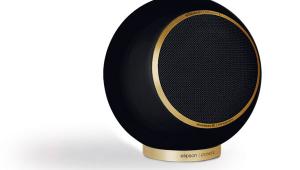Monitor Audio GX200 - £2,300
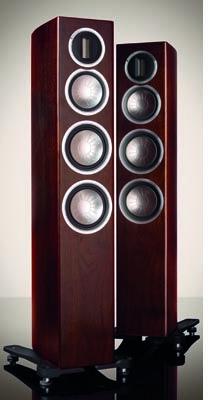
Monitor Audio began operations nearly forty years ago, but is probably best known for introducing and proselytising metal diaphragm drive units, initially for its tweeter domes and soon afterwards for the cones used in its bass and midrange drivers. Add in some very classily veneered enclosures that were manufactured in its own cabinet shop and the company established a template that still holds good today.
Twenty years down the line, plenty has changed of course, but the same core values remain at the heart of Monitor Audio’s more upmarket ranges. The first Platinum series models appeared some four years ago and have been covered extensively in Hi-Fi Choice in recent times: PL100 (HFC 343); PL200 (HFC 330) and PL300 (HFC 301).
A number of the advanced design techniques that were first introduced in those models have now ‘trickled down’ into the new and rather less costly Gold GX series tested here and it’s these design ‘luxuries’ that we’re most interested in with the GX200, the model that Monitor Audio’s representative thought showcased the strengths of the new range best.
New GoldNot that these £2,300 GX200s can be considered inexpensive by most standards, but they’re certainly aimed at a competitive sector of the serious loudspeaker sector. The complete Gold GX range is very extensive, consisting of four stereo pairs plus several models specifically intended for multichannel home cinema. This GX200 is the smaller of two floorstanders, and is a genuine three-way design, using twin bass drivers to keep the front view fashionably slim.
Narrow floorstanders like this are potentially physically unstable, all too easily knocked over by unwary passing children, for example. Supplying a proper plinth arrangement to counter this possibility shouldn’t be the tricky task that some brands seem to encounter, though fortunately Monitor Audio has thought this through carefully and clearly and come up with a rather clever arrangement, which is not only highly effective but also quite attractive style-wise. Two substantial cast alloy pieces are bolted to each speaker, each accommodating two feet located well outside the footprint of the loudspeaker itself. Though the arrangement is mostly positive, the actual spike-locking arrangements are not ideal.
The requirements for an ideal cone diaphragm are very complex, inasmuch as they have to achieve a compromise between several conflicting variables. Low mass is one vital ingredient, in order to maximise sensitivity and ensure rapid responsiveness. However, rigidity is important to maintain pistonic behaviour across as wide a bandwidth as possible and it’s also important that potential resonances within the cone are well damped.
Monitor Audio has long opted for a deep-anodised aluminium/magnesium alloy as a cone material; the deep-anodising process converting the surface to an oxide that considerably improves the stiffness. Whereas the Platinum series also added ‘dimples’ to the surface further to increase the stiffness, alongside a costly honeycomb sandwich construction to provide damping, the simpler cones used in the Gold GX series stick to a metal/oxide diaphragm but have replaced the dimples withmore pronounced ridges – a ring around the location where the voice-coil former terminates, plus a series of radial arms reaching out towards the cone edge.
By adding a degree of depth dimension, extra stiffness is achieved, while finite element analysis (FEA) has also been used to create an optimum parabolic profile.The twin 140mm bass drivers each have 100mm diameter cones and operate up to a nominal 400Hz, crossing over to the 100mm anodised alloy midrange unit that has a 95mm cone.
That in turn operates up to the 2.6kHz crossover point to the tweeter, which is a vertically oriented ribbon-type device, similar but not identical to that used throughout the Platinum range. The ultra-light (18mg) diaphragm is roughly 55x8.5mm and is energised by neodymium magnets and loaded by a modest horn. The delicate diaphragm is protected under a wide-spaced metal mesh.
All four drive units are secured by substantial through-bolts that clamp their motors to the back of the enclosure, adding to the overall bracing but also enabling a measure of gasket-decoupling between the driver frames and the front panel.
Bending the BoxIn another nod towards the Platinum models, the enclosure is created by building up and bonding together multiple layers of thin MDF. The end result is 20mm thick, but this technique allows the sides to form a gentle curve and avoid the focused-frequency standing waves that are generated by parallel faces. Tighter radii are then used to soften the appearance of the front and rear edges and the whole has additional internal bracing.
Five alternative finishes are listed in the brochure – three real wood veneers alongside black or white piano gloss. Our examples came in a dark brown ‘dark walnut’ veneer (pictured), which is probably the most understated amongst the light ‘natural oak’ and reddish ‘bubinga’ alternatives available.
The slim rear panel accommodates a modest diameter port and foam bungs are supplied as an option – probably worth trying if the speakers have to be mounted close to a wall. Twin terminal pairs are solidly attached to a vertically oriented cast-alloy panel; bi-wiring or bi-amping is therefore available (the terminal pairs separating the bass units from the mid and treble), though as supplied the speakers are fitted with proper wire ‘jumper’ links.
MA’s own silver-plated cabling called Pureflow Silver is used internally, along with high-quality crossover components that include air-core and laminated-core inductors and polypropylene capacitors. Metal mesh grilles are supplied for those who prefer to keep their drivers hidden and attach via hidden sub-veneer magnets, so that unsightly mounting arrangements are avoided.
Position with CareWhile the in-room measurements had suggested that output from the 43Hz-tuned port might interact with our 50Hz room mode and lead to significant mid-bass boom, this didn’t really turn out to be a problem in practice. While inserting the port bungs did give a slightly more even bass alignment, it was also a little too dry and the overall sound balance, with the speakers sited well clear of walls, was definitely preferred with the ports actively contributing.
Using the bungs makes sense if the speakers have to be close to a wall, but they certainly sounded rather bass-light when located a metre or so out into the room with the bungs inserted in the ports. This might well be because the fundamental character of the Gold GX200 tends to be a little on the bright and light side of neutral, probably because the output of the ribbon tweeter is quite strong at the bottom end of its operating range.
This is not a bass-excavator of a speaker; while it sounds suitably agile and hangs on in pretty well, the bass end is not the part of the band that one particularly notices. Rather it leads with its upper midband, presence and lower treble, so that that voices are notably clear and open, ensuring fine intelligibility of lyrics and speech. However, it should also be pointed out that the overall sound balance is just a little lacking in warmth and bass weight.
The Presence debate
If the top half of the audio band sounds a shade exposed, it’s also quite clean and sweet with it and this does mean that plenty of fine detail is well projected, even when the system is playing at whisper-quiet levels. The down side, of course, is that the sound can become a little aggressive when playing some recordings at high volumes. However, it’s nice not to disturb the rest of the household when listening late at night, while still getting to hear plenty of vocal expression.
The efficacy of the enclosure shape and construction technique is evident enough in the way the sound is notably free from any boxy character. The stereo soundstage is always well detached from the speakers themselves, with precise central image focus, a well located lateral spread and a decent attempt at delivering appropriate depth perspectives, too even though the latter is mildly compromised by the slightly forward tonal balance.
IntelligibilityAlthough this speaker has a decidedly modern appearance, we did find that its tonal balance was very well suited to replaying old-fashioned vinyl discs, as this medium tends to have a sweeter and slightly more restrained presence than CD in general and the more compressed examples of modern recording practices in particular. We also found the GX200s very satisfactory on day-to-day TV and radio viewing and listening, as these sources in particular require the superior voice band intelligibility that goes part and parcel with the Monitor Audio.
Many designs today tend to pull down the presence band deliberately, as this can be helpful in allowing the volume to be turned up high without the overall sound becoming unpleasantly aggressive. But with such loudspeakers one then often has to turn up the volume somewhat higher than desirable simply in order to understand what’s going on. The much more costly speakers that we were using prior to installing these GX200s did indeed have significantly less relative output through the presence and top end. Although moving to the smaller and much less expensive GX200s did require some adjustment in terms of low end authority, clarity and overall warmth, their extra top end energy often proved welcome, especially when listening to dialogue on a movie soundtrack.
Every loudspeaker design represents a collection of compromises, which is why the responsible review should always recommend personal audition prior to purchase. This, of course, is becoming harder as the number of hi-fi stores contract nationwide, but remains critical, especially for speakers.
The GX200 does somewhat favour the upper half of the audio band, but it does this rather well, with a sweetness and detail projection that many rivals fail to match.
LIKE: Unboxy with wide dynamics and good imaging
DISLIKE: Can sound bright, lacks some bass authority and warmth
WE SAY: A stylish speaker free from boxiness with wide dynamic range, but the bass can lack weight
DETAILS
Product: Monitor Audio Gold GX200
Origin:UK/China
Type: Three-way floorstanding loudspeaker
Weight: 22.2kg
Dimensions: (WxHxD) 170x990x300mm
Features:
• C-CAM ribbon tweeter
• 100mm anodised alloy midrange driver
• 2x140mm anodised alloy bass drivers
• Port on rear near base
• Finished in three real wood veneers or piano gloss black or white
Distributor: Monitor Audio
Telephone: 01268 740580
Website: monitoraudio.co.uk
 |
Inside this month's issue:
Ruark R610 music system and Sabre-R standmount speakers, PMC twenty.23i Active, floorstanders, English Acoustics Downton preamplifier, Bluesound NODE ICON preamp/streamer, Ortofon Concorde Music Blue MM cartridge and much, much more
|






